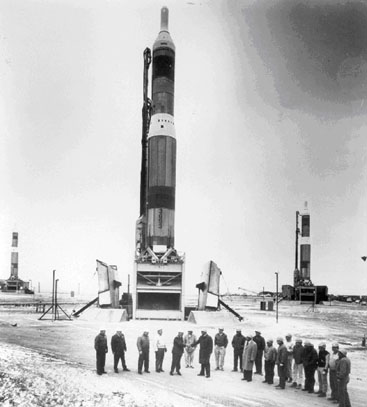In the spring of 1954 the Air Force dramatically accelerated its intercontinental ballistic missile (ICBM) program with the goal of fielding an operational missile force by the end of the decade. But building missiles was only part of the equation; the Air Force also needed to develop a complex support infrastructure of test sites and launch facilities to enable the missile force to become a part of the United States strategic nuclear deterrent.
To build those missile facilities, the Air Force turned to the Army Corps of Engineers. In early 1955 the Los Angeles District began work on a massive rocket engine test facility at Edwards AFB, California, and over the course of the next 12 years the Corps of Engineers also built test facilities at Vandenberg AFB, California, as well as the sprawling missile launch complex at Cape Canaveral, Florida. Between 1958 and 1967 the Army also built 1,200 ICBM missile silos for three generations of ICBMs: the temperamental first generation Atlas and Titan I, the powerful Titan II, and the solid-fuel Minuteman.
Managing such a large and diverse program required substantial resources. Initially the Corps assigned responsibility for the construction of the various missile sites to its Engineer Districts, but it soon became apparent that a central coordinating body was necessary to oversee the entire project. In July 1959 the Chief of Engineers established a special branch of the Los Angeles District called the Los Angeles Field Office (LAFO), to handle the program. LAFO reported directly to the Chief of Engineers.
Although the creation of LAFO provided a greater degree of centralized coordination and control to the mammoth project, the changes were not enough. In August 1960 the Army established the Corps of Engineers Ballistic Missile Construction Office (CEBMCO), an independent organization reporting directly to the Chief of Engineers, to supervise site construction. To further improve coordination between the Corps and the Air Force, an April 1961 agreement between the two services placed CEBMCO under the operational control of the Air Force.
The growth of CEBMCO mirrored its expanded responsibilities. When established it had a staff of 27, but within 6 years grew to 3,000 people managing 22 projects in 17 states. CEBMCO’s responsibilities encompassed the entire construction effort. Although the Corps of Engineers did not design the launch facilities, it reviewed the plans, solicited and evaluated proposals, and awarded the contracts. CEBMCO then supervised construction, and after the launch facilities were completed, it stayed on the job as a member of the Air Force site activation task force, an organization tasked with turning the empty silos into operational missile bases.
Building the missile launch sites and support facilities was one of the largest military construction projects ever undertaken by the Corps. By 1962 construction costs were already in excess of $2 billion, and in the next 5 years CEBMCO spent billions more completing the Minuteman program. By 1961 Army contractors had already moved 26 million cubic yards of earth and stone, poured more than 3 million cubic yards of concrete, and used 764,000 tons of steel. Another indication of the size and importance of the program was the labor force devoted to it: in early 1961, more than 21,000 construction workers were laboring around the clock to build ICBM silos.
By the time it was disbanded in 1967, CEBMCO had played a vital role in fabricating the support infrastructure of the United States land-based strategic nuclear deterrent. But the story does not end there. Future vignettes will examine CEBMCO’s Atlas, Titan I, Titan II, and Minuteman facility construction programs.

Colonel James Thompson (center, left), Commander of the Site Activation Task Force, Lowry AFB, Colorado, congratulates W.G. Christmas, general manager of American Machine and Foundry Company's Titan Field Operations Division, on the activation of the first Titan I squadron in April 1962.
* * *
April 2001